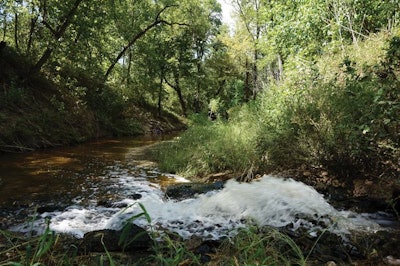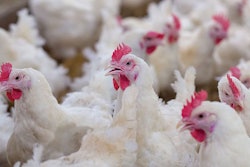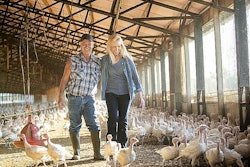
Sanderson Farm Inc.’s Waco, Texas, poultry wastewater operation reflects the company’s commitment to environmental stewardship and resource conservation.
Along with fully treating 1.5 million gallons of water for direct discharge into a tributary of the Brazos River, the facility employs several innovative techniques to increase operational sustainability. Because of this, Waco Processing was selected as the runner-up for the 2018 U.S. Poultry & Egg Association Clean Water Award for the full treatment category.

Jon Davis, division manager (from left); Corey Whitten, environmental supervisor; Stephanie Shoemaker, manager of environmental; Dwayne Holifield, environmental manager of operations; and Rian McMorris, environmental manager, pose at Sanderson Farms' Waco, Texas, wastewater treatment facility. | Austin Alonzo
Operational details
The wastewater treatment operation serves the integrated poultry company’s 11-year-old big bird processing facility. Waco Processing is capable of processing 1.25 million chickens weekly and processes an average of 11.25 million live pounds each week. The company employs more than 1,200 in the Waco area and contracts with more than 80 nearby poultry farms. Sanderson is the third-largest poultry company in the U.S., according to WATT PoultryUSA’s Top Broiler Company rankings.
The facility fully treats water using water screening, secondary screening, anaerobic treatment with flow equalization, activated sludge treatment and ultraviolet disinfection. The offal area employs a dissolved air flotation (DAF) unit to separate solids from the wastewater. Effluent from the DAF unit is gravity fed into a 20 million-gallon, covered anaerobic lagoon for biological treatment.
Water is then pumped from the lagoon into an anoxic basin where it is mixed with return activated sludge from the clarifier and return mixed liquor from the aeration basin for denitrification. From the anoxic basin, water flows into an aeration basin where it is treated with oxygen. In the clarifier, solids are settled before the water is transferred to the ultraviolet light chamber for disinfection. From there, the water is directed down stair steps – to increase the dissolved oxygen content of the water – and is discharged into Tehuacana Creek.
Sustainability
Waco Processing’s treatment process yields a significant amount of natural gas, which is used in the plant itself. Inside the covered lagoon, the chemical process of methane fermentation yields 75 percent methane biogas.
When purified through an on-site pressure swing adsorption system, the biogas is pipeline-quality natural gas. It is pumped directly into the plant and used instead of purchased natural gas. In 2017, 87.2 percent of the natural gas used at the plant was generated on-site.
The facility finds other ways to save resources, too. The DAF unit uses only dissolved air – rather than dissolved air and binding chemicals – to remove solids from influent. Water is also repurposed for further use in the processing plant.
















